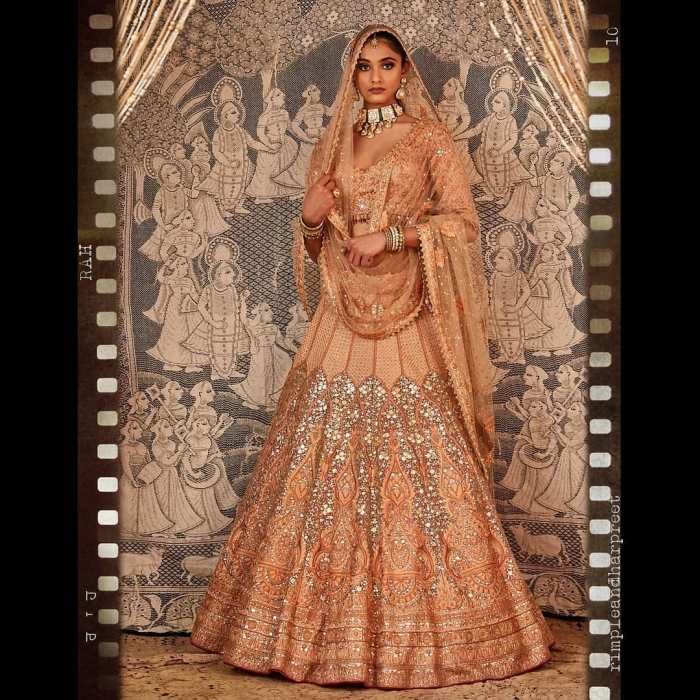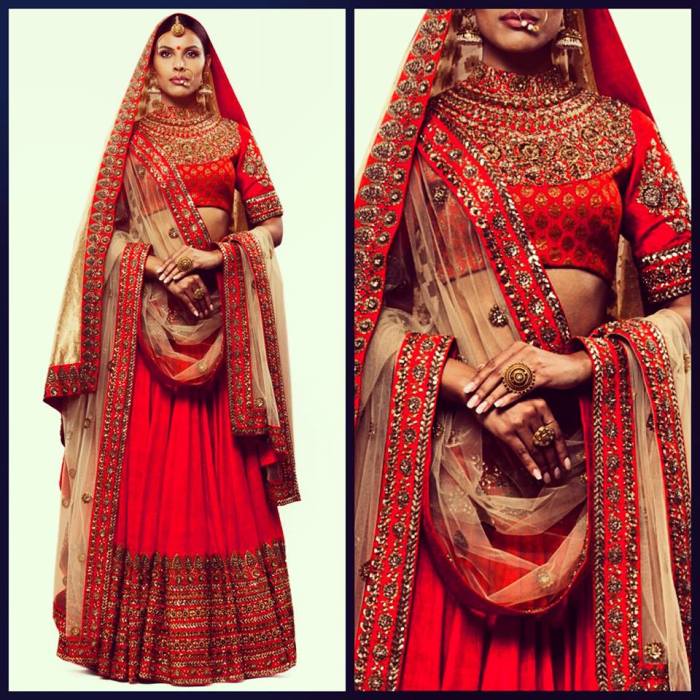Indian Designer Wedding Dresses A Style Guide
Popularity and Trends in Indian Designer Wedding Dresses
Indian designer wedding dresses – The Indian wedding dress market is a vibrant tapestry of tradition and innovation. Current trends reflect a fascinating interplay between classic techniques and contemporary aesthetics, resulting in breathtakingly beautiful and diverse designs.
Fabric Trends in Indian Designer Wedding Dresses
Luxury fabrics are highly sought after. Silk, especially Banarasi and Kanjeevaram silks, remain staples, appreciated for their rich textures and lustrous sheen. Velvet, with its opulent feel, is another popular choice, often used for winter weddings. Lightweight fabrics like georgette and chiffon are increasingly incorporated for more comfortable, contemporary styles, particularly in warmer climates. The use of sustainable and ethically sourced fabrics, such as organic cotton and recycled silk, is also gaining momentum.
Evolution of Design Styles in Indian Wedding Attire
Over the last decade, Indian wedding attire has witnessed a significant shift. While traditional silhouettes like lehengas, sarees, and anarkalis remain dominant, modern interpretations have emerged. There’s a growing preference for lighter, more fluid designs, incorporating Western elements like A-line cuts and fitted bodices. The embellishments, while still opulent, often feature a more minimalist approach, emphasizing clean lines and sophisticated detailing.
Popular Color Palettes in Indian Designer Wedding Dresses
Traditional colors like red, gold, and maroon continue to hold their significance, symbolizing auspiciousness and prosperity. However, pastel shades, particularly blush pink, ivory, and mint green, are gaining popularity, offering a softer, more romantic aesthetic. Deep jewel tones like emerald green, sapphire blue, and ruby red also remain popular choices, adding a touch of regal elegance.
Incorporation of Traditional Embroidery Techniques
Traditional Indian embroidery techniques, such as zardozi, aari, and gota patti, are seamlessly integrated into modern designs. Zardozi, known for its intricate gold and silver threadwork, often adorns lehengas and sarees, adding a touch of regal splendor. Aari embroidery, with its delicate floral motifs, is used to create soft, romantic looks. Gota patti, with its vibrant colored ribbons, adds a playful and festive touch to contemporary designs.
Key Designers and Their Styles
Several leading designers are shaping the landscape of Indian wedding fashion. Their unique styles cater to diverse tastes and preferences, ranging from classic elegance to modern minimalism.
Profiles of Leading Indian Wedding Dress Designers
Designer A is known for their opulent, heavily embellished lehengas, often featuring rich jewel tones and intricate zardozi work. Designer B specializes in creating sleek, minimalist designs, often using lighter fabrics and incorporating contemporary cuts. Designer C blends traditional Indian aesthetics with Western influences, creating unique and innovative styles.
Comparison of Design Philosophies
Designer A and B represent contrasting design philosophies. Designer A embraces maximalism, celebrating opulence and tradition. Designer B champions minimalism, prioritizing clean lines and contemporary silhouettes. This contrast showcases the breadth and diversity within Indian wedding fashion.
Signature Elements of a Specific Designer
Designer C’s signature element is the incorporation of unexpected details, such as asymmetrical cuts, unconventional color combinations, and the use of unexpected textures. These unique touches elevate their designs, making them instantly recognizable.
Price Ranges and Target Audiences of Different Designers
| Designer | Price Range | Target Audience | Style |
|---|---|---|---|
| Designer A | High-end (₹500,000+) | High-profile clients, brides seeking opulent designs | Traditional, heavily embellished |
| Designer B | Mid-range (₹100,000 – ₹500,000) | Modern brides seeking minimalist elegance | Contemporary, minimalist |
| Designer C | Mid-to-high range (₹200,000 – ₹700,000) | Fashion-forward brides seeking unique and innovative styles | Fusion of traditional and modern elements |
Regional Variations in Indian Wedding Dress Styles
India’s rich cultural diversity is reflected in its wedding attire. Different regions boast unique styles, colors, and embellishments, each carrying profound cultural significance.
Distinct Characteristics of Wedding Dresses from Different Regions
South Indian wedding sarees, particularly Kanjeevaram silks, are known for their rich, vibrant colors and intricate gold zari work. North Indian lehengas often feature elaborate embroidery and heavy embellishments. Bengali wedding sarees are characterized by their bold red color and intricate designs.
Cultural Significance of Embellishments and Colors
The color red is widely associated with auspiciousness and prosperity across many regions. Gold embellishments symbolize wealth and status. Specific motifs, such as peacocks or floral patterns, hold regional significance, reflecting local traditions and beliefs.
Examples of Traditional Wedding Attire from Different Regions
A South Indian bride might wear a Kanjeevaram silk saree, adorned with gold zari work, paired with traditional temple jewelry. A North Indian bride might choose a heavily embellished lehenga, often in red or gold, with intricate embroidery. A Bengali bride might opt for a vibrant red Banarasi saree with intricate gold embroidery.
Key Differences in Silhouette and Fabric Choices Across Regions
- South India: Sarees are dominant, often made of Kanjeevaram silk, with a focus on rich colors and intricate zari work. Silhouettes are generally more traditional and flowing.
- North India: Lehengas are prevalent, often featuring heavy embroidery and embellishments. Silhouettes can vary, from traditional to more modern styles.
- West India: A variety of styles are seen, including sarees and lehengas, often incorporating regional embroidery techniques like Bandhani or Patola.
The Impact of Modern Influences on Traditional Designs: Indian Designer Wedding Dresses

Source: googleusercontent.com
Contemporary Indian wedding fashion is a dynamic blend of tradition and modernity. Western influences have subtly shaped designs, leading to innovative and stylish creations.
Influence of Western Fashion Trends
Western trends, such as A-line silhouettes, fitted bodices, and the use of lighter fabrics, have been incorporated into Indian wedding dresses, resulting in more contemporary styles. The use of lace, tulle, and other Western fabrics has also added a new dimension to traditional designs.
Blending Traditional and Modern Elements
Contemporary designers skillfully blend traditional Indian embroidery techniques with modern silhouettes and fabrics. For example, a traditional lehenga might be crafted from a modern fabric like silk georgette, adorned with intricate zardozi work.
Hypothetical Wedding Dress Design, Indian designer wedding dresses
A hypothetical wedding dress could feature a flowing A-line silhouette in ivory silk georgette, adorned with delicate aari embroidery depicting traditional Indian floral motifs. The bodice could be fitted, incorporating a modern neckline, while the skirt would fall in soft, graceful layers. This design seamlessly blends traditional elegance with contemporary sophistication.
Innovative Uses of Modern Materials

Source: stylesgap.com
The use of sustainable and ethically sourced fabrics, such as organic cotton and recycled silk, is gaining traction. These materials allow designers to create beautiful wedding dresses while minimizing their environmental impact.
Sustainability and Ethical Considerations in Indian Wedding Dress Production
The growing awareness of environmental and social responsibility is impacting the Indian wedding dress industry. Designers are increasingly prioritizing sustainable and ethical practices.
Environmental Impact of Production
The production of Indian wedding dresses can have a significant environmental impact due to the use of water-intensive fabrics, dyes, and energy-intensive production processes. The disposal of these garments also poses an environmental challenge.
Ethical Concerns Related to Labor Practices
Ethical concerns exist regarding labor practices in some segments of the industry. Ensuring fair wages, safe working conditions, and the avoidance of child labor are crucial aspects of ethical production.
Growing Trend Towards Sustainable and Ethically Sourced Materials
There is a growing trend towards using sustainable and ethically sourced materials, such as organic cotton, recycled silk, and natural dyes. This approach minimizes the environmental impact and promotes fair labor practices.
Examples of Designers Who Prioritize Sustainability and Ethical Production
Several designers are actively championing sustainable and ethical practices, using eco-friendly materials and ensuring fair wages for their workers. Their commitment to responsible production is setting a positive example for the industry.
Illustrative Examples of Indian Designer Wedding Dresses
The artistry of Indian wedding dress design is evident in the intricate details and creative use of fabrics, colors, and embellishments.
Detailed Description of a Specific Indian Designer Wedding Dress
Imagine a lehenga crafted from blush pink silk, adorned with delicate aari embroidery depicting blossoming lotus flowers. The bodice is fitted, featuring a sweetheart neckline, while the skirt flows gracefully to the floor. The inspiration behind the design is the serene beauty of a lotus flower, symbolizing purity and elegance.
Visual Impact of Color and Texture
A designer’s skillful use of color and texture can dramatically impact the overall aesthetic of a wedding dress. A deep emerald green velvet lehenga, embellished with gold zardozi work, creates a regal and opulent look. The rich texture of the velvet, combined with the shimmering gold threadwork, adds a touch of luxurious drama.
Descriptive Narrative of a Wedding Dress Showcasing Intricate Hand Embroidery
The dress is a masterpiece of hand embroidery. Thousands of tiny sequins and beads are meticulously sewn onto a cream-colored silk base, creating a breathtaking cascade of shimmering light. Delicate floral motifs, interspersed with intricate paisley patterns, cover the entire garment. The effect is mesmerizing, transforming the dress into a work of art.
FAQs
What is the average price range for an Indian designer wedding dress?
Prices vary significantly depending on the designer, fabric, embroidery, and embellishments. Expect a wide range, from several thousand to tens of thousands of dollars.
How long does it typically take to have a custom-designed Indian wedding dress made?
The timeframe can range from several months to a year, depending on the designer’s workload and the complexity of the design.
Where can I find Indian designer wedding dresses outside of India?
Many designers offer international shipping, and some high-end boutiques in major cities worldwide carry collections of Indian designer wedding dresses.
What are some popular fabrics used in Indian designer wedding dresses?
Popular choices include silk (Banarasi, Kanjeevaram, Mysore), brocade, velvet, and net, often combined with intricate embroidery.



















